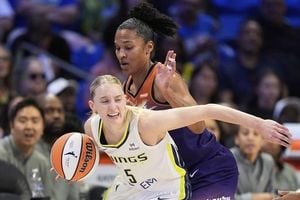In a striking evolution of the entertainment landscape, YouTube is no longer just a platform for casual vlogs or viral clips; it is rapidly becoming a major player in television and film. This transformation is underscored by YouTube creator Michelle Khare, who, with her show "Challenge Accepted," is vying for a Primetime Emmy Award in the outstanding hosted nonfiction series category, marking a significant milestone for digital content creators.
Khare, who boasts 5.1 million subscribers, is among several YouTube creators whose shows have earned spots on the Emmy nomination ballot, including "Hot Ones" and "Good Mythical Morning." The nomination process closes on June 23, 2025, and these entries symbolize YouTube's growing legitimacy as a home for high-quality, television-caliber content.
Just a year ago, YouTube CEO Neal Mohan advocated for the Television Academy to recognize creators on the platform alongside traditional TV and streaming services. This push has gained traction, as evidenced by the complex and professional nature of Khare's productions. For instance, her "Houdini stunt" episode last year involved a crew of 80 people, including camera operators, sound engineers, stunt teams, and a live audience, reflecting the scale of a traditional television set. Upcoming projects, like her planned attempt to replicate a Tom Cruise stunt from "Mission: Impossible – Rogue Nation," involve collaborations with helicopter staff and specialized camera crews, some of whom have worked on the original films.
Each episode's development is a lengthy process, often spanning months. The "Houdini" episode required three to four months of research and preparation, six weeks of stunt training, and eight to ten weeks of post-production work, including editing and sound mixing. This timeline rivals that of premium television productions, dispelling the notion that digital content is hastily assembled.
Moreover, YouTube's audience engagement is increasingly centered on television screens. Approximately 45% of Khare's viewers watch her content on TVs, a trend mirrored across the platform. In the first quarter of 2025, more Americans watched YouTube on TV screens than on mobile devices for the first time, signaling a shift in viewing habits. This shift is supported by Nielsen data showing YouTube as the number one distributor of television content for three consecutive months leading up to mid-2025.
The platform's influence is further highlighted by a recent survey from Looper Insights, which found that 66% of consumers discover TV or film content via YouTube. Additionally, 61% incorporate YouTube into their regular streaming routines, and 34% consider it a primary source for television and film content. Media executives are taking notice; among 65 surveyed, 84% view YouTube as a viable platform for launching long-form content, and 30% are actively considering it for upcoming releases.
Warner Bros. has quietly embraced this trend by releasing over 30 full-length films on YouTube for free earlier this year, demonstrating confidence in the platform's reach and impact. However, despite YouTube's burgeoning stature, creators face a crossroads. While some, like Ms Rachel, have signed deals with platforms such as Netflix, and MrBeast has brought his "Beast Games" to Prime Video, many fans prefer their favorite YouTubers to remain on the platform that launched their careers. Indeed, 54% of survey respondents feel YouTubers are more authentic and better suited to YouTube.
Conversely, nearly 74% of media executives note that creator-led shows often underperform on services like Netflix and Prime, attributing this to poor audience migration and an overreliance on follower counts rather than content quality. This dynamic suggests that YouTube may be the best home for creator-driven content, reinforcing its role as a major player in the entertainment ecosystem.
Khare emphasizes that winning an Emmy is about more than accolades; it represents industry recognition and maturity. "Winning an Emmy is not just about being heralded as good. Really, it’s an indication of our industry maturing," she said. Such recognition would attract higher-caliber crews, larger audiences, and increased advertising revenue, vital components for sustaining and elevating content quality.
Her production company operates much like a traditional studio, handling development, production, post-production, and marketing internally. For example, the "Houdini" episode's extensive team included specialists in various fields to ensure authenticity and high production values. This approach challenges stereotypes about digital content being low-budget or amateurish.
Khare also highlights the economic and cultural implications of Emmy recognition for YouTube creators. "Anytime a cultural change like this is imminent, it’s exciting when it happens the first time. Because it inspires all of the following generations to continue in the path of the door that’s been opened," she explained. She envisions a future where content is judged purely on artistic merit and cultural impact, transcending the divisions between digital and traditional media.
Meanwhile, the broader media industry is undergoing significant changes. Disney has experienced four rounds of layoffs over the past ten months, with the latest being the largest, reflecting ongoing restructuring. Paramount Global is reportedly offering $15 million to settle President Donald Trump’s lawsuit against CBS News, a high-profile legal development.
The television landscape itself is shifting. Broadcast networks plan to air 36 scripted series this fall, down from a peak of 66 in 2017, indicating a contraction in traditional scripted programming. Meanwhile, Starz reported 13 million paid streaming subscribers at the end of Q1 2025, underscoring the competitive streaming market.
Advertising trends also reveal shifts, particularly for LGBTQ+ creators, who have seen a significant drop in brand deals since 2023. Nearly 39% of Fortune 500 brand executives plan to reduce spending on Pride-related marketing in 2025, highlighting challenges in inclusivity and representation in advertising.
In the midst of these changes, leadership shifts are occurring, such as Donna Speciale stepping down as TelevisaUnivision’s U.S. ads chief, with Tim Natividad, formerly of TikTok and Roku, stepping in. These moves reflect the industry's adaptation to evolving content consumption and advertising landscapes.
As YouTube continues to solidify its role as a dominant distribution platform, creators like Michelle Khare are at the forefront of a cultural and industrial shift. Their success challenges traditional notions of television and film production, blending the lines between digital and conventional media. With Emmy recognition possibly on the horizon, the future of TV might just be streaming from a platform once dismissed as merely a video-sharing site.




